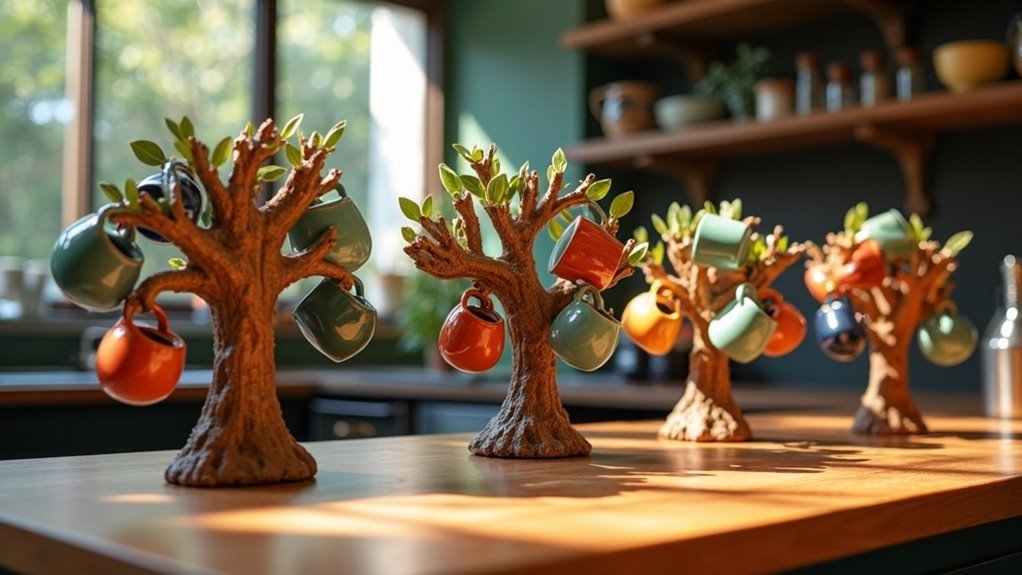Scandinavian egg coffee is a distinctive brewing technique that involves mixing a raw egg with coffee grounds, resulting in a rich and smooth beverage devoid of bitterness. This unique method dates back to the 1800s and is often associated with nostalgic family gatherings. The final product boasts a creamy texture and a translucent burnt sienna hue, making it a perfect companion to sweet treats. If you’re interested in learning how to prepare this delightful coffee and exploring its cultural significance, there’s a wealth of information to discover.
Key Takeaways
- Scandinavian egg coffee, a unique brewing method, originated in the 1800s among immigrants in Northern Minnesota as a solution to poor water quality and weak coffee.
- The brewing process is distinctive; it involves mixing a raw egg with coffee grounds, then boiling and filtering the mixture to achieve a remarkably smooth texture.
- This coffee is known for its rich, creamy mouthfeel and lack of bitterness, allowing for the subtle flavors to shine through in a beautiful translucent burnt sienna color.
- Today, modern chefs are breathing new life into this traditional beverage, adapting recipes to fit contemporary palates while honoring its cultural roots.
- Savoring Scandinavian egg coffee can evoke cherished memories and strengthen connections to heritage, making it a delightful experience to share with friends and family.
History and Origin of Egg Coffee
Egg coffee has a fascinating history that dates back to the 1800s, when Scandinavian immigrants in Northern Minnesota sought a solution for the poor water quality and weak coffee they encountered.
This unique brew, often called “church basement coffee,” emerged during Lutheran church gatherings, where communities came together to enjoy coffee. By mixing a raw egg with coffee grounds before boiling, these immigrants adapted Swedish and Norwegian customs to create a rich, flavorful beverage.
Though it nearly vanished with the rise of drip coffee makers, egg coffee is experiencing a revival, captivating modern chefs and coffee enthusiasts eager to explore its heritage and unique preparation methods.
Brewing Process
To brew a cup of Scandinavian egg coffee, you’ll start by boiling nine cups of water in a saucepan or an enamel coffee pot.
In a separate bowl, mix a whole raw egg with your coffee grounds until well combined.
Once the water is boiling, add the egg-coffee mixture and let it simmer for 3-5 minutes. This brewing method allows the egg to clarify the coffee by binding bitter compounds and clumping the grounds.
After simmering, pour in one cup of cold water to settle the grounds, then filter the coffee through a fine mesh strainer before serving.
Savor the unique flavors and smooth texture of this delightful coffee experience! Enjoy!
Flavor Profile and Characteristics
When you sip Scandinavian egg coffee, you’ll immediately notice its rich, smooth texture that envelops your palate like a warm embrace.
The delightful absence of bitterness allows the subtle flavors to emerge without any harsh notes. This unique combination makes it an ideal companion for sweet treats, evoking cherished memories of family gatherings.
Experience the comforting allure of this distinctive coffee that celebrates both tradition and flavor.
Rich, Smooth Texture
Although it may sound unconventional, Scandinavian egg coffee delivers a rich, smooth texture that captivates the senses.
This traditional Swedish preparation achieves its creamy mouthfeel by blending a whole egg with coffee grounds during brewing. The egg’s clarifying properties create a stunning translucent burnt sienna color, allowing for enhanced flavor extraction without cloudiness.
As the egg whites bind to bitter compounds, they form a “raft,” further contributing to the velvety experience. The result is a clean, mild taste that evokes nostalgia, making each sip a delightful reminder of family gatherings and cherished coffee traditions.
Lack of Bitterness
Scandinavian egg coffee is a delightful choice for coffee enthusiasts due to its exceptional smoothness and enjoyable flavor profile. The brewing process incorporates egg whites that effectively bind to bitter compounds, creating a “raft” of proteins that enhance the overall taste while minimizing any acrid notes. This method results in a velvety mouthfeel and a silky body that coffee drinkers appreciate. The finished brew showcases a translucent burnt sienna color, highlighting its mild and clarified nature. By adding cold water after boiling, the grounds settle and further reduce any undesirable bitterness. This unique brewing technique not only offers a nostalgic taste but also makes it an ideal option for communal gatherings.
| Characteristic | Description |
|---|---|
| Lack of Bitterness | Smooth and enjoyable flavor |
| Egg Whites | Bind and extract bitter compounds |
| Silky Body | Velvety mouthfeel |
| Final Color | Translucent burnt sienna |
Modern Revival and Adaptation
As interest in unique coffee experiences grows, modern chefs are breathing new life into the age-old tradition of Scandinavian egg coffee. Inspired by Scandinavian immigrants, these culinary innovators are embracing the Third Wave coffee movement, which champions artisanal techniques and cultural connections within the coffee community.
While the traditional recipe involves a time-consuming brewing process, many chefs are creating modern adaptations that maintain the essence of egg coffee but streamline preparation. You might encounter variations in ingredients or methods, showcasing the versatility of this classic coffee drink.
This revival not only honors heritage but also invites coffee lovers to explore its rich, flavorful history in the world of coffee.
Personal Experiences and Anecdotes
As you recall the comforting aroma of coffee wafting through your grandmother’s kitchen, you can almost feel the warmth of family gatherings surrounding you.
Each cup brewed is more than just a drink; it’s a ritual that reconnects you to cherished traditions and shared moments.
The communal experience of preparing this beloved beverage invites you to honor your roots while creating new memories together, celebrating the rich culture and history of coffee.
Childhood Memories Revisited
While you might think of coffee as a simple morning ritual, the first sip of egg coffee can transport you back to cherished moments with loved ones. You remember the warm, comforting aroma filling the kitchen, as your grandmother whisked eggs and brewed coffee with care.
This unique blend evokes deep childhood memories, bringing forth:
- The sound of laughter during family gatherings
- The communal joy of brewing together
- The delightful taste enhanced by the rich, creamy texture of the egg
- A sense of belonging and connection to heritage
For coffee lovers, egg coffee is more than just a drink; it’s a nostalgic journey steeped in love and tradition, reminding us of the bonds we share over a warm cup.
Family Traditions and Rituals
Egg coffee isn’t just a drink; it’s a beloved coffee ritual that unites people. During coffee-related gatherings, you share stories over this unique brew, creating cherished memories. You might recall your grandmother’s special touch, linking you to those treasured moments of connection. The communal aspect of brewing fosters a sense of belonging, reminiscent of coffee get-togethers where culinary traditions shine. Each household often has its own twist on the recipe, reflecting individual tastes while honoring the time-honored method.
| Coffee Gathering | Cherished Moment |
|---|---|
| Sunday brunch | Grandma’s recipe |
| Holiday parties | Sharing stories |
| Summer picnics | Laughing together |
| Winter evenings | Cozy warmth |
| Coffee reunions | Passing down traditions |
Communal Brewing Experience
Imagine gathering around a steaming pot of Scandinavian egg coffee, where the air is filled with laughter and the rich aroma of freshly brewed coffee mingles with nostalgia.
This communal brewing experience brings coffee lovers together, fostering connections that span generations.
- You share techniques passed down through the years, enhancing your coffee knowledge.
- The brewing process sparks joyful conversations about different coffee varieties and methods.
- Memories of childhood gatherings over coffee resurface, creating nostalgic connections.
- Enjoying this traditional beverage highlights its cultural significance within the world of coffee.
Each cup you pour becomes a reminder of heritage and the shared experience that strengthens bonds, transforming a simple drink into a cherished ritual that celebrates the love of coffee.
Safety and Tips for Preparation
When it comes to preparing Scandinavian egg coffee, ensuring safety is just as important as mastering the unique brewing technique. Start by using fresh pasteurized eggs to minimize any risk of salmonella.
When boiling water, make sure it reaches a high temperature to effectively kill any potential bacteria. After boiling, adding cold water helps settle the grounds and reduces bitterness in your brew.
Keep an eye on the pot while simmering to prevent overflow, which can lead to burns or messes. If you’re wary of raw eggs, consider boiling them first for an extra layer of safety while maintaining the rich flavor of your coffee.
Enjoy the unique taste of Scandinavian egg coffee while prioritizing your safety in the kitchen!








